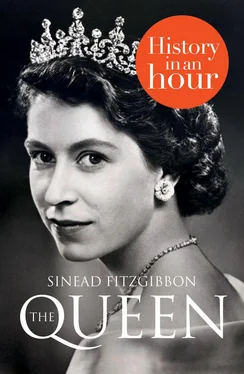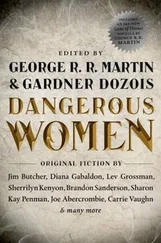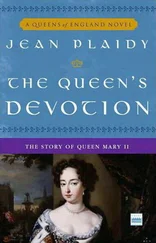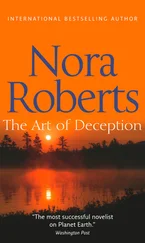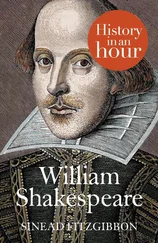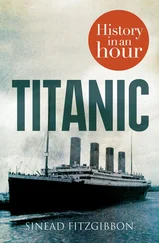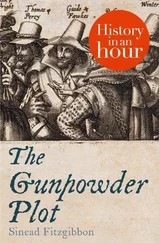After a hurried breakfast, both Elizabeth and Margaret donned identical dresses of ‘white silk with old cream lace’ and ‘robes of purple velvet with gold on the edge’. Following a ‘ jolty’ ride to Westminster Abbey in a horse-drawn carriage, the sisters took their place alongside their grandmother in the Royal Box. ‘I thought it all very, very wonderful. . the arches and beams at the top were covered with a sort of haze of wonder as Papa was crowned, at least I thought so.’
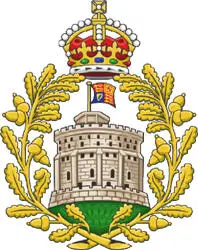
Badge of the House of Windsor during George VI’s Reign
However, as the two-and-a-half hour ceremony dragged on, Elizabeth’s attention began to wane: ‘At the end the service got rather boring, as it was all prayers. Grannie and I were looking to see how many more pages to the end, and we turned one more and then I pointed to the word at the bottom of the page and it said “Finis”. We both smiled at each other and turned back to the service.’
Although she was most likely unaware of it at the time, her father’s coronation was to prove to be an excellent training ground for the young Princess – in just fifteen short years, she would find herself following reverently in his footsteps, as she made her way into the Abbey to be crowned Queen Elizabeth II.
Prior to 1936, the Yorks had placed little emphasis on their daughters’ schooling. This was mainly due to the fact that the Duchess herself had never received much in the way of educational instruction, while the Duke harboured less-than-fond memories of a miserable childhood spent in a grim schoolroom, an experience he did not wish to replicate for Elizabeth and Margaret. Consequently, the girls’ education was limited to sporadic lessons in basic subjects, like reading, writing and a little mathematics, from their governess, Crawfie. Later, this rather meagre curriculum was supplemented with French lessons from another governess, along with history and geography tutorials from Queen Mary. In addition, both Elizabeth and Margaret devoted a significant amount of time to non-academic pursuits such as riding, music, dancing and drawing.
For Elizabeth, this all changed following her father’s ascension to the throne. As heiress presumptive, it was now imperative for the Princess to receive an education which would adequately prepare her for her future role as Queen. And so, from the age of thirteen, she began taking intensive lessons from the Vice-Provost of Eton College, Sir Henry Marten. He instructed her on a variety of difficult subjects including constitutional history, the role of monarchy, and parliamentary procedures. Her father also took an interest in her training, allowing her to look over his shoulder as he studied State papers, as well as quietly coaching her on the monarch’s duties and responsibilities.
Although this new state of affairs was a big departure for Elizabeth, she diligently applied herself to the task in hand. Displaying a sharp intellect, she absorbed information rapidly, and had little difficulty understanding even the most complex of subjects. It soon became obvious that, despite the shortcomings in her early education, Elizabeth was an exceptional student. It was not deemed necessary for Margaret to receive the same lessons as her sibling, and the exclusion irked her. But like it or not, the two sisters, who were once so close, were now on vastly divergent paths. With Elizabeth’s star now in the ascendancy, Margaret had little choice but to fade, somewhat begrudgingly, into the background – a situation which would be perpetuated long into adulthood.
Конец ознакомительного фрагмента.
Текст предоставлен ООО «ЛитРес».
Прочитайте эту книгу целиком, купив полную легальную версию на ЛитРес.
Безопасно оплатить книгу можно банковской картой Visa, MasterCard, Maestro, со счета мобильного телефона, с платежного терминала, в салоне МТС или Связной, через PayPal, WebMoney, Яндекс.Деньги, QIWI Кошелек, бонусными картами или другим удобным Вам способом.
